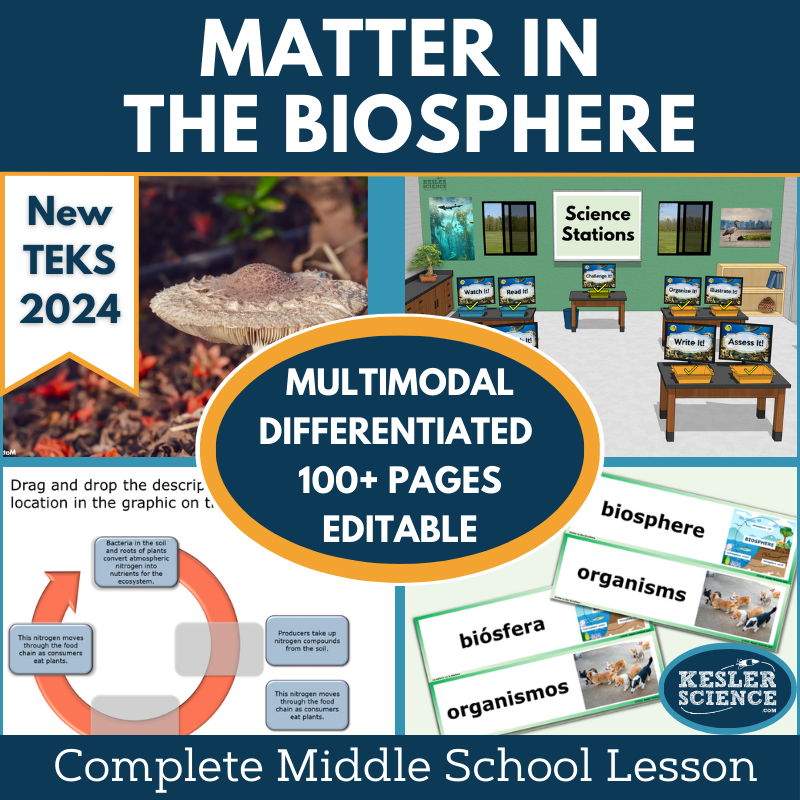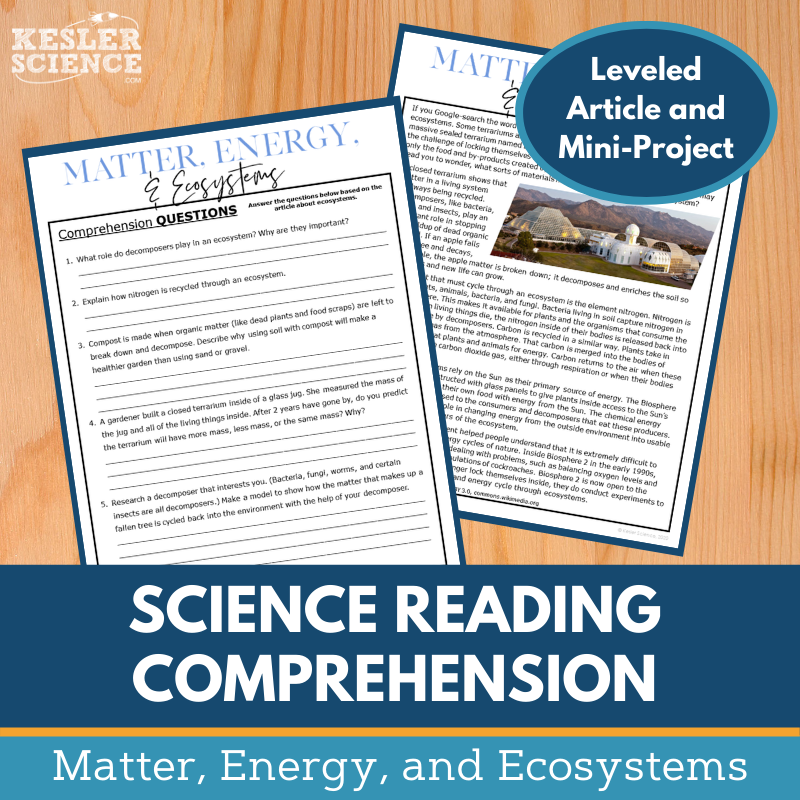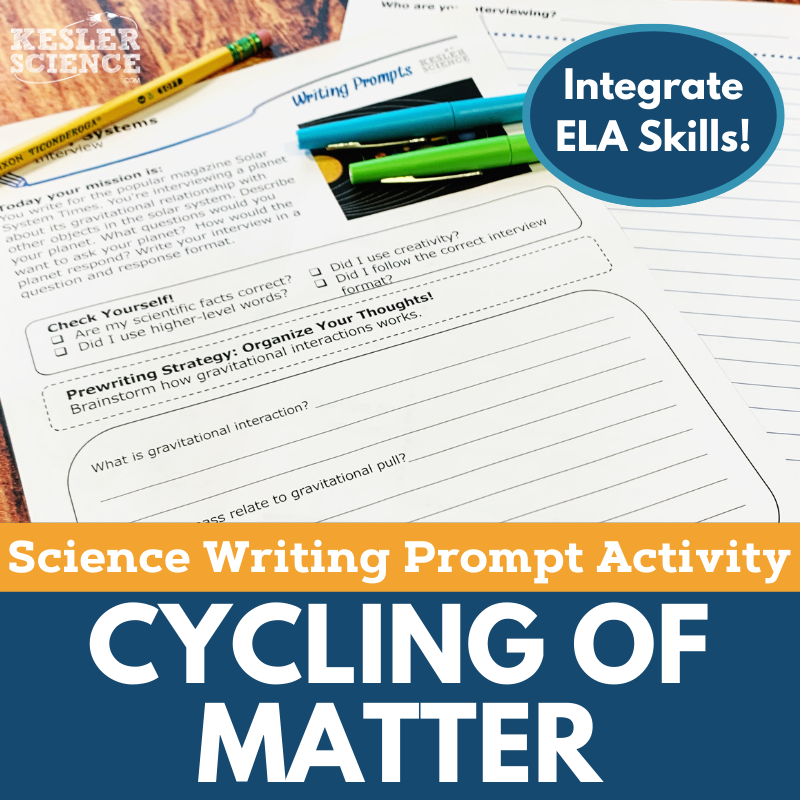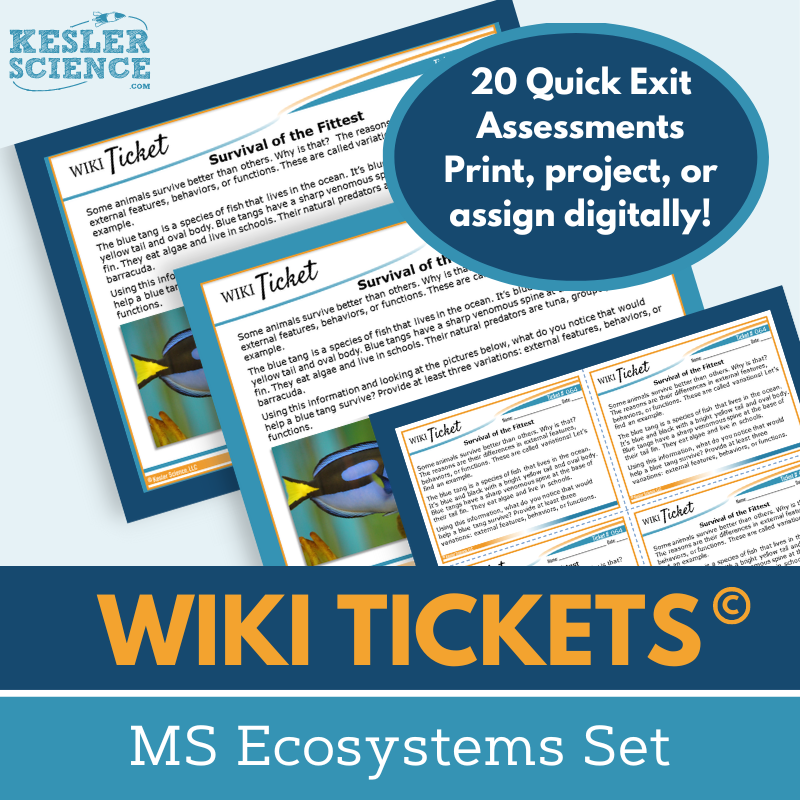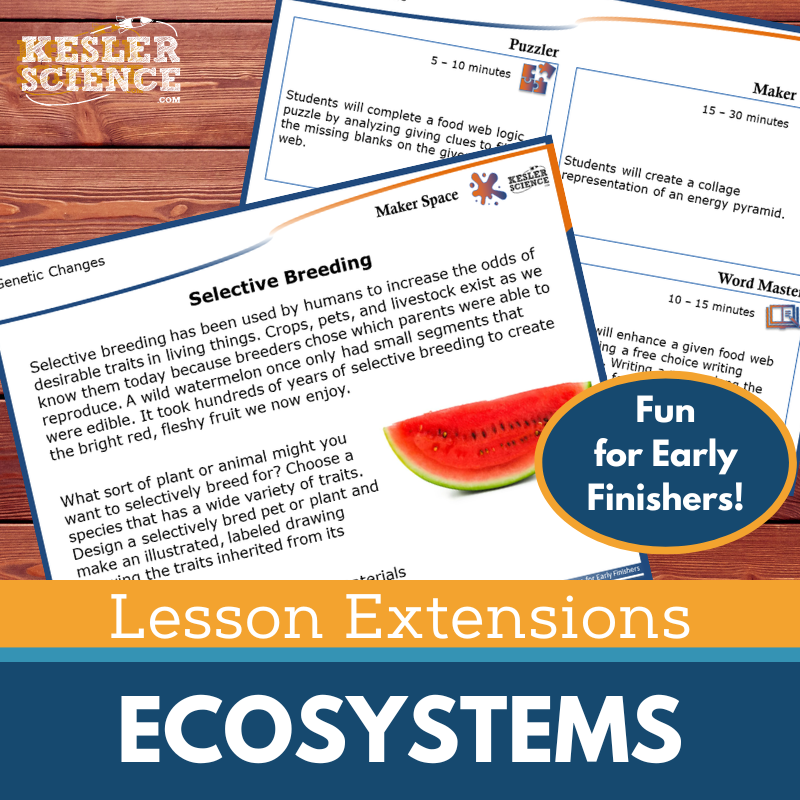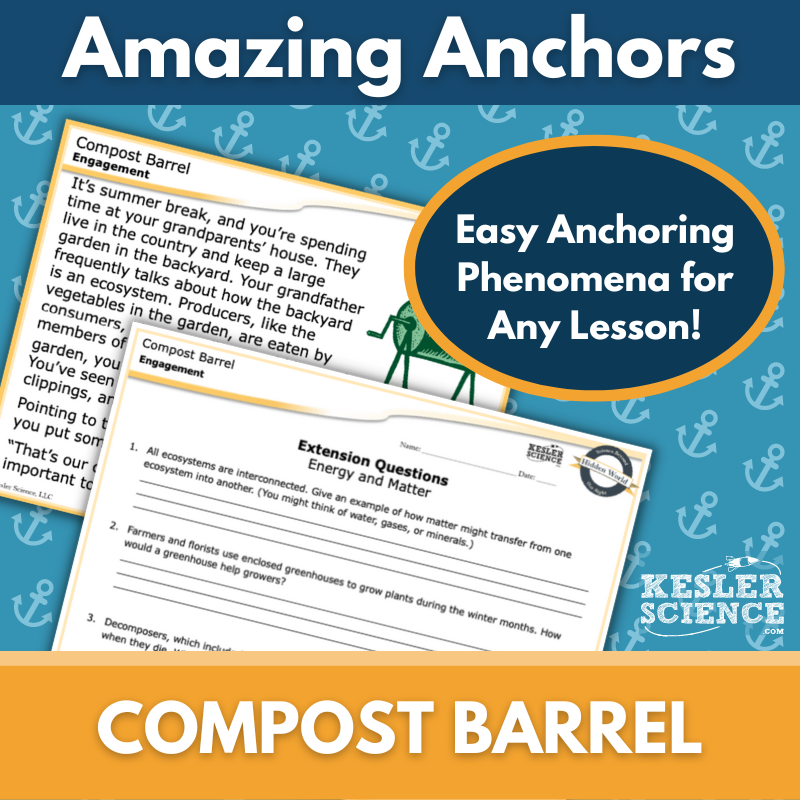Matter in the Biosphere Activities for Middle School Science
Students will explore how ecosystems sustain themselves through energy flow and matter recycling with this engaging, student-led lesson. The resources below will give students a comprehensive understanding of matter in the biosphere. All of the following materials are also included in the Kesler Science Membership.
The Kesler Science Matter in the Biosphere 5E Lesson provides a comprehensive, student-led unit on how ecosystems sustain themselves through energy flow and matter recycling. Designed for middle school and junior high students, it includes editable presentations, worksheets, choice projects, and assessments, all aligned with the 2021 TEKS 7.12B standard. With multimodal learning, differentiation, and Spanish translations, this lesson offers flexibility for both print and digital formats.
Following the 5E Model, students engage with objectives, vocabulary, and class discussions before exploring concepts through a differentiated station lab with nine stations. Input stations include hands-on demos, reading passages, research tasks, and videos, while output stations allow students to demonstrate understanding through categorization, writing, illustration, and assessments. A bonus challenge station provides extension activities.
Explanation resources include editable PowerPoints, interactive notebook templates in English and Spanish, and structured note-taking guides. Students elaborate through choice projects on ecosystem sustainability, and evaluation materials include STAAR 2.0-aligned assessments, review questions, and worksheets. The lesson is adaptable for in-class and virtual learning environments, ensuring maximum engagement and student success.
The Kesler Science Matter in the Biosphere 5E Lesson provides a comprehensive, student-led unit on how ecosystems sustain themselves through energy flow and matter recycling. Designed for middle school and junior high students, it includes editable presentations, worksheets, choice projects, and assessments, all aligned with the 2021 TEKS 7.12B standard. With multimodal learning, differentiation, and Spanish translations, this lesson offers flexibility for both print and digital formats.
Following the 5E Model, students engage with objectives, vocabulary, and class discussions before exploring concepts through a differentiated station lab with nine stations. Input stations include hands-on demos, reading passages, research tasks, and videos, while output stations allow students to demonstrate understanding through categorization, writing, illustration, and assessments. A bonus challenge station provides extension activities.
Explanation resources include editable PowerPoints, interactive notebook templates in English and Spanish, and structured note-taking guides. Students elaborate through choice projects on ecosystem sustainability, and evaluation materials include STAAR 2.0-aligned assessments, review questions, and worksheets. The lesson is adaptable for in-class and virtual learning environments, ensuring maximum engagement and student success.
Engage your middle school students with this student-led station lab aligned to TEKS 7.12B, exploring how ecosystems sustain themselves through energy flow and nutrient recycling in the biosphere. Designed for in-class or virtual learning, this interactive lesson allows students to take charge of their learning while you facilitate.
Students work through nine differentiated stations, encountering new concepts through activities such as demonstrations, videos, readings, and research. They demonstrate their understanding by organizing information, illustrating models, writing responses, and completing assessments. A bonus challenge station provides extension activities, and English and Spanish reading passages support differentiated learning.
This low-prep, high-engagement resource encourages active learning and critical thinking.
Engage your middle school students with this student-led station lab aligned to TEKS 7.12B, exploring how ecosystems sustain themselves through energy flow and nutrient recycling in the biosphere. Designed for in-class or virtual learning, this interactive lesson allows students to take charge of their learning while you facilitate.
Students work through nine differentiated stations, encountering new concepts through activities such as demonstrations, videos, readings, and research. They demonstrate their understanding by organizing information, illustrating models, writing responses, and completing assessments. A bonus challenge station provides extension activities, and English and Spanish reading passages support differentiated learning.
This low-prep, high-engagement resource encourages active learning and critical thinking.
The Matter in the Biosphere Student Choice Projects align with the 2021 TEKS standard 7.12B, allowing middle school students to choose a project that fits their preferred output style. A project page outlines six student-led options plus a “design your own” project, all with an editable rubric for teacher, peer, or self-assessment. This resource is also included in the Matter in the Biosphere Complete Lesson for TEKS 7.12B.
These flexible, multimodal projects offer creative ways for students to demonstrate their understanding. Teachers can adjust the rubric to fit grading needs. Two versions of the project page support differentiation, with modified options for students needing remediation and challenge options for advanced learners.
The projects use standard classroom supplies like paper, markers, and scissors, with many options available for digital completion.
The Matter in the Biosphere Student Choice Projects align with the 2021 TEKS standard 7.12B, allowing middle school students to choose a project that fits their preferred output style. A project page outlines six student-led options plus a “design your own” project, all with an editable rubric for teacher, peer, or self-assessment. This resource is also included in the Matter in the Biosphere Complete Lesson for TEKS 7.12B.
These flexible, multimodal projects offer creative ways for students to demonstrate their understanding. Teachers can adjust the rubric to fit grading needs. Two versions of the project page support differentiation, with modified options for students needing remediation and challenge options for advanced learners.
The projects use standard classroom supplies like paper, markers, and scissors, with many options available for digital completion.
The Energy Pyramids & Energy Flow Inquiry Lab aligns with NGSS MS LS2-3, helping students model the cycling of matter and energy flow between biotic and abiotic components of an ecosystem. Students will create an energy pyramid for an assigned ecosystem, reinforcing key ecological concepts.
This resource includes three differentiated lab versions to support diverse learning needs. The Dependent Lab provides a mix of procedural instructions and inquiry questions, the Modified Lab offers a structured experience with sentence stems and multiple-choice questions, and the Independent Lab encourages student-driven exploration with minimal guidance. Reflection questions guide students through Claim, Evidence, and Reasoning statements.
Teacher resource pages, answer keys, and editable materials simplify planning. Required materials include Styrofoam cups and colored markers. This engaging lab fosters hands-on learning and deeper understanding of energy transfer in ecosystems.
The Energy Pyramids & Energy Flow Inquiry Lab aligns with NGSS MS LS2-3, helping students model the cycling of matter and energy flow between biotic and abiotic components of an ecosystem. Students will create an energy pyramid for an assigned ecosystem, reinforcing key ecological concepts.
This resource includes three differentiated lab versions to support diverse learning needs. The Dependent Lab provides a mix of procedural instructions and inquiry questions, the Modified Lab offers a structured experience with sentence stems and multiple-choice questions, and the Independent Lab encourages student-driven exploration with minimal guidance. Reflection questions guide students through Claim, Evidence, and Reasoning statements.
Teacher resource pages, answer keys, and editable materials simplify planning. Required materials include Styrofoam cups and colored markers. This engaging lab fosters hands-on learning and deeper understanding of energy transfer in ecosystems.
This Matter, Energy, and Ecosystems Science Reading Comprehension Lesson helps students explore the cycling of matter and flow of energy in ecosystems through a nonfiction article, comprehension questions, and a labeled flowchart activity. Designed for grades 6-8, with Lexile levels between 1100-1300, the leveled passage supports science literacy and reading comprehension.
The resource includes five to seven comprehension questions, a hands-on mini-project, and a Cornell notes template. Students can engage with the content in both print and digital formats, making it suitable for in-person and virtual learning environments like Google Classroom, MS Teams, Schoology, and Canvas.
Ideal for sub plans, extra credit, ISS, or whole-class instruction, this resource fosters critical thinking, classroom discussions, and textual analysis while reinforcing key ecosystem concepts.
This Matter, Energy, and Ecosystems Science Reading Comprehension Lesson helps students explore the cycling of matter and flow of energy in ecosystems through a nonfiction article, comprehension questions, and a labeled flowchart activity. Designed for grades 6-8, with Lexile levels between 1100-1300, the leveled passage supports science literacy and reading comprehension.
The resource includes five to seven comprehension questions, a hands-on mini-project, and a Cornell notes template. Students can engage with the content in both print and digital formats, making it suitable for in-person and virtual learning environments like Google Classroom, MS Teams, Schoology, and Canvas.
Ideal for sub plans, extra credit, ISS, or whole-class instruction, this resource fosters critical thinking, classroom discussions, and textual analysis while reinforcing key ecosystem concepts.
The Cycling of Matter Science Writing Prompt Activity engages middle school students in a creative, poetry-based writing exercise to reinforce their understanding of matter cycling and energy flow in ecosystems. Aligned with MS LS2-3, this low-prep, student-centered activity enhances science reasoning and exploration while supporting both in-person and virtual learning.
This resource includes teacher directions with an answer guide, project ideas, and rubrics; projection and print handouts in both full-size and half-sheet formats; and a digital PowerPoint version compatible with Google Slides. Ideal for cross-curricular activities, pre-test assessments, student choice projects, or differentiation, this writing prompt fosters engagement, creativity, and science literacy. It works well for early finishers, extra credit, make-up work, or TELPAS samples and can be displayed on a bulletin board or compiled into a student anthology.
The Cycling of Matter Science Writing Prompt Activity engages middle school students in a creative, poetry-based writing exercise to reinforce their understanding of matter cycling and energy flow in ecosystems. Aligned with MS LS2-3, this low-prep, student-centered activity enhances science reasoning and exploration while supporting both in-person and virtual learning.
This resource includes teacher directions with an answer guide, project ideas, and rubrics; projection and print handouts in both full-size and half-sheet formats; and a digital PowerPoint version compatible with Google Slides. Ideal for cross-curricular activities, pre-test assessments, student choice projects, or differentiation, this writing prompt fosters engagement, creativity, and science literacy. It works well for early finishers, extra credit, make-up work, or TELPAS samples and can be displayed on a bulletin board or compiled into a student anthology.
The WIKI Tickets© Ecosystems Set provides engaging, flexible formative assessments for 6th-8th grade science, offering multiple ways to check student understanding. This set includes 20 assessments, each available in five formats: a full-screen projection version, three printable handout options (full, split, and quarter-page sizes), and an interactive digital version compatible with PowerPoint and Google Slides.
Aligned with NGSS and TEKS standards, these assessments ensure comprehensive coverage of key ecosystem topics, including biodiversity, ecological succession, food chains, human impact on oceans, natural selection, and more. Each standard has at least one ticket, with some topics featuring multiple assessments. A bonus table of contents file is included to show alignment.
Designed for both in-person and virtual learning, WIKI Tickets© can be used as exit tickets, bellringers, or quick checks. Students can respond on printed handouts, their own paper, or digitally in a 1:1 or remote setting. These colorful, interactive assessments help educators gauge student progress effectively in any learning environment.
The WIKI Tickets© Ecosystems Set provides engaging, flexible formative assessments for 6th-8th grade science, offering multiple ways to check student understanding. This set includes 20 assessments, each available in five formats: a full-screen projection version, three printable handout options (full, split, and quarter-page sizes), and an interactive digital version compatible with PowerPoint and Google Slides.
Aligned with NGSS and TEKS standards, these assessments ensure comprehensive coverage of key ecosystem topics, including biodiversity, ecological succession, food chains, human impact on oceans, natural selection, and more. Each standard has at least one ticket, with some topics featuring multiple assessments. A bonus table of contents file is included to show alignment.
Designed for both in-person and virtual learning, WIKI Tickets© can be used as exit tickets, bellringers, or quick checks. Students can respond on printed handouts, their own paper, or digitally in a 1:1 or remote setting. These colorful, interactive assessments help educators gauge student progress effectively in any learning environment.
Lesson Extensions provide engaging, student-choice activities designed to challenge early finishers and deepen their understanding of ecosystems. These activities encourage critical thinking and creativity while preventing distractions and filling downtime with meaningful learning opportunities. Aligned to NGSS and TEKS standards, they help scaffold learning for students ready to explore ecosystems further.
Each extension includes four interactive components: Puzzler for problem-solving, Maker Space for hands-on STEAM activities, Tech Connection for digital demonstrations, and Word Master for creative writing. With teacher directions, answer keys, and both print and projection versions, these extensions are ideal for lesson wrap-ups, enrichment, or independent challenges.
Covering topics such as biodiversity, biomes, ecological succession, food webs, human impact, and energy flow, these extensions provide rigorous, engaging opportunities for students to extend their learning beyond the basics of ecosystems.
Lesson Extensions provide engaging, student-choice activities designed to challenge early finishers and deepen their understanding of ecosystems. These activities encourage critical thinking and creativity while preventing distractions and filling downtime with meaningful learning opportunities. Aligned to NGSS and TEKS standards, they help scaffold learning for students ready to explore ecosystems further.
Each extension includes four interactive components: Puzzler for problem-solving, Maker Space for hands-on STEAM activities, Tech Connection for digital demonstrations, and Word Master for creative writing. With teacher directions, answer keys, and both print and projection versions, these extensions are ideal for lesson wrap-ups, enrichment, or independent challenges.
Covering topics such as biodiversity, biomes, ecological succession, food webs, human impact, and energy flow, these extensions provide rigorous, engaging opportunities for students to extend their learning beyond the basics of ecosystems.
This Amazing Anchors Phenomenon Lesson engages students in the cycling of matter in ecosystems through a real-world composting example. It begins with an introductory reading on compost barrels, followed by comprehension and extension questions to prepare students for deeper learning. An explanatory reading then breaks down the science behind composting and cycling matter, reinforced with additional questions.
This no-prep resource includes teacher directions, answer keys, projection slides, and both print and digital formats for Google Classroom and other LMS platforms. A differentiated version provides sentence starters to support student comprehension. Designed to bookend a lesson, these readings serve as engaging supplements to reinforce learning in any classroom setting. Aligned with NGSS standard MS LS2-3, this lesson offers both print and digital access for flexible implementation.
This Amazing Anchors Phenomenon Lesson engages students in the cycling of matter in ecosystems through a real-world composting example. It begins with an introductory reading on compost barrels, followed by comprehension and extension questions to prepare students for deeper learning. An explanatory reading then breaks down the science behind composting and cycling matter, reinforced with additional questions.
This no-prep resource includes teacher directions, answer keys, projection slides, and both print and digital formats for Google Classroom and other LMS platforms. A differentiated version provides sentence starters to support student comprehension. Designed to bookend a lesson, these readings serve as engaging supplements to reinforce learning in any classroom setting. Aligned with NGSS standard MS LS2-3, this lesson offers both print and digital access for flexible implementation.
Year-Round Resources
These year-round activities will increase your students' understanding of many middle school science topics. All of these activities are also included in the Kesler Science Membership.
Visual Data & Graphing
You're not alone if your students struggle with understanding graphs, charts, and tables. It's a skill that takes an enormous amount of practice. This resource will help students build a strong foundation in analyzing data and creating their own data visualizations.
Bell Ringers and Warm-Ups
These middle school science bell ringers are an excellent way to engage your students as soon as they walk into your classroom. This comprehensive FULL YEAR resource includes everything you need to start off each science class with an interesting warm-up activity.
Review Board Games
Each game board has been carefully designed to keep students engaged. There are 10 different action spaces on each board and dozens of question cards. All of the actions are related to science concepts and keep the students motivated throughout the game.
Each game is ready to play. Simply print out the board and the cards and let the students enjoy reviewing nine different units.
Essential Questions and Standards
Below are the essential questions and standards associated with the lessons and activities included in the atoms unit. This topic is only one of more than 100 middle school science topics included in the Kesler Science Membership.
-
How are ecosystems sustained by the continuous flow of energy within the biosphere?
-
How are ecosystems sustained by the continuous recycling of matter and nutrients within the biosphere?
-
TEKS Science - 7.12B Matter in the Biosphere
Kesler Science Membership
Imagine never having to search for another middle school science lesson again. The membership gives you access to ALL of the Kesler Science products in one place (Yes, including everything above).
Say goodbye to long hours of lesson prep.

